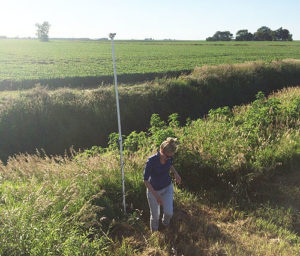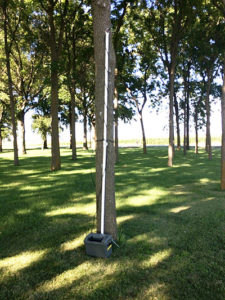
A typical central Illinois agricultural setting, with a stationary acoustic monitoring station, with microphone mounted on a pole.
The Illinois Bat Conservation Program field team has finished work at our 4th field site this summer, north of the town of Oblong, IL. Our field work has focused on collecting data using bat acoustic detectors. These detectors record the echolocation calls bats use to navigate as they fly and hunt for flying insect prey at night. Using an ultrasonic microphone mounted on top of a pole, bat acoustic detectors record calls to a digital file. We leave these detectors at each site for at least 4 nights in order to account for variability in weather. Programed to turn on shortly before sunset and turn off after sunrise, each detector can potentially record thousands of files in the few days that they are deployed. Sometimes the recorder picks up high frequency insect noise or other interference but, for the most part, they record bat echolocation pulses. Because each species has a slightly different call, analyzing the range of frequency, duration, and other call characteristics often allows us to identify the bat species. Setting up detectors in different habitat types, and studying the number of bat calls at each site, gives us new data on habitat use by bats, which can inform management decisions.

A stationary acoustic monitoring station set up on the side of a tree, making it less likely to be noticed by bats.
When we place these detectors in the field, we have to camouflage the microphone pole so bats do not notice them. Bats are intelligent and aware creatures, and will be curious of any new object in their habitat. If they are suspicious of the detector, they may avoid it or circle around it, both of which would skew our data. Normally, when people think of camouflage, they think of color. Bats have great eyesight and use echolocation to perceive their environment, but typically do not use color cues to identify objects. Instead, we hide the microphone pole from their echolocation calls. We do this by placing the pole against an object that is already present in the area, such as a tree or fence post. Because the microphone pole is against a tree, it appears to be part of an existing object, rather than a new object. Bats are less likely to notice this new object, and the pole will be less likely to alter their behavior.

